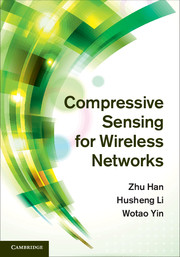3 - Compressive sensing framework
from Part I - Compressive Sensing Technique
Published online by Cambridge University Press: 05 June 2013
Summary
Despite the relatively short history of CS theory pioneered by the work by Candes, Romberg, and Tao [67-69] and Donoho [70], the numbers of studies and publications in this area have become amazingly large. On the other hand, the applications of CS are just beginning to appear. The inborn nature that many signals can be represented by sparse vectors has been recognized in many areas of applications. Examples in wireless communication include the sparse channel impulse response in the time domain, the sparse unitization of the spectrum, and the time and spatial sparsity in the wireless sensor networks. For each of these sparse signals, there are innovative signal acquisition schemes that not only satisfy the requirements by the CS theory, but are also easily realizable on hardware. Efficient signal-recovery algorithms for each system are also available. They guarantee stable signal recovery with high probability.
In this chapter, we provide a concise overview of CS basics and some of its extensions. In subsequent chapters, we focus on CS algorithms and specific areas of CS research in wireless communication.
This chapter begins with Section 3.1, which gives the motivation of CS, illustrates the typical steps of CS by an example, summarizes the key components CS, and discusses how nearly sparse signals and measurement noise are treated in robust CS. Following these discussions, Section 3.2 compares CS with traditional sensing and examines their advantages and disadvantages.
- Type
- Chapter
- Information
- Compressive Sensing for Wireless Networks , pp. 51 - 68Publisher: Cambridge University PressPrint publication year: 2013

